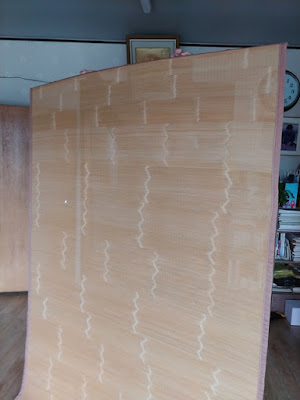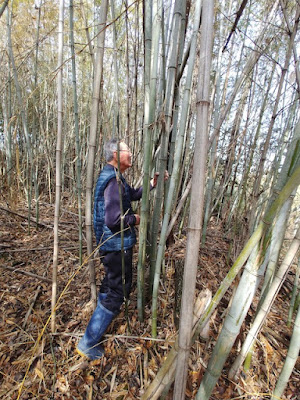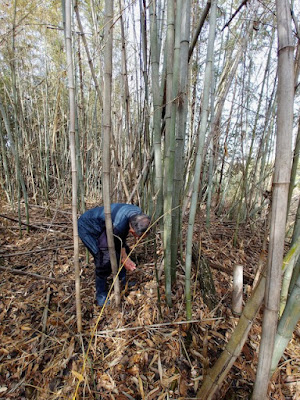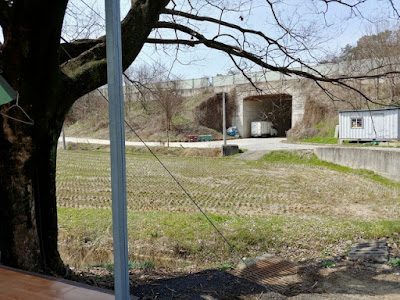Over two weeks ago on March 16, I traveled from Jeonju to Damyang. Though the latter is south of Jeonju, the easiest way to get there was to take an express bus for over two hours to Gwangju, and then head north to Damyang. Normally, you'd take a local bus for an hour and then figure out how to get a cab from the bus stop to the village I wanted to visit (Bongsan-myeon, a bit pictured here). But I was impatient to arrive as I knew I couldn't stay through the lunch hour, and Koreans are really serious about eating meals right on time. Lunch begins between noon and 12:30pm, no questions!
Some of the basic tools and materials necessary to work, including a seat cushion for the floor. I asked the first taxi driver at the bus terminal if he'd be willing to take me all the way there, and he must have thought I had come from there because he was trying to negotiate the fare, even though the meter was running. It took another several minutes for him to input the address into his phone (mostly because he couldn't see what he was doing and misspelled it over and over), and when we arrived, I was like, this is clearly not anyone's home. He assumed I had been there before!
After paying him what he asked for, which was more than the metered amount, I called Bak Seong-chun, Jeolla Province's intangible cultural property holder of jukryeom (bamboo blinds used to block the sun like window blinds or to hang decoratively indoors). There is only one other property holder of this technique in Korea, and he is in Gyeongsang Province in Tongyeong, a coastal city in the southeast. I almost couldn't visit because his village doesn't want outsiders to come in during pandemic.This is an old framed photo of him working alongside his late mother, who taught him this technique. He was born here in 1938 and lives with his wife and eldest son, who have different lifelong needs for his care. It was very hard for me to be aware of that because I have had a relatively easy and privileged life when it comes to being able bodied and healthy. Seeing the repercussions of both human deterioration and tragic car crashes made me sad, though there wasn't anything to do about it. He himself was also born with middle and ring fingers fused on both hands, which don't prevent him from making excellent work.
Here, Mr. Bak is unwrapping a screen in progress that he knows he will never finish. He kept saying, even with glasses on, my eyes are too dark. I mentioned my father's eye surgery but Mr. Bak seemed to think that was not an option for him, it's just life and you deal with it.
The weights are wrapped in paper (I think they are rocks...) so that they don't rub and fray or damage either the threads or the bamboo. It's important to use silk threads but those are more expensive than nylon ones. But the latter slip around too much and it's hard to keep a straight line or pattern.
The weaving frame is so simple. I wish I could make things like this but my head is not exactly built to conjure such solutions.
My reflection in the mirror is the only proof that I was even there! Mr. Bak showed me early on in my visit a big screen. I marveled at the zigzag patterns that come from the nodes in the bamboo. To be able to make these patterns, you have to keep all of your bamboo from each plant in order. What a hardcore task.
Mr. Bak is not a short man, so you can kind of imagine how huge this screen is.
I still cannot get over keeping the bamboo in order. He said you arrange by the cardinal directions, and I was lucky to be able to see a video of him working the next day at the bamboo museum in Damyang. He also showed me a book he had commissioned of his work, which had full page photos of every step, which must have been extremely exhausting to make for him (as well as the video. In both, he has to dress in traditional Korean clothes and do work in weather that probably was hot. In particular, it looked really hot in the video and he was in full sun).
I wanted to see the process from the very beginning, so we walked to a bamboo grove not far up the hill behind his home.
It didn't take long for him to choose a good plant, always between three and four years old. Since he's been doing this for 60 years, he can tell very easily.
All he had brought was a small saw, and got to work on both sides of this bamboo stem. Because it was so tall, it didn't come crashing down but simply got stuck amidst its neighbors.
So he dragged over the bottom of it and sawed off a piece, leaving the rest behind.
I said, what about the rest? And he said, I'll get it later. Of course. I am so used to ideas of private property and taking what you need and clearing out right away, and also used to ideas of theft. His lament was that this used to be a very good grove, but people keep cutting away all the bamboo shoots in spring to eat, which means no stems to harvest in three or four years.
Back at home, Mr. Bak trimmed the piece he brought back and then got to work scraping the outer skin away.
He had a different knife for this step, which stays outside. In a video at at the museum, I saw footage of another artisan using a double-handled curved blade for this step. Whatever works. I appreciate that his body becomes the anchor on the top of the stem; it's braced in his abdomen.
Once he shaved away the skin on one section, he trimmed both ends. This is not how he normally works; because I was interested in how bamboo would be processed for making hanji screens, he intentionally used only the space between the nodes. For his work, he keeps the entire length intact, shaves the nodes down to be flush with the rest of the stem, and then splits lengthwise.
On a simple wood block, he split the stem lengthwise. It went so fast that I missed the visual but the sound was extremely satisfying. Then he went on to split in quarters, eighths, and so on. For this batch, he didn't even bother splitting the entire thing; we only worked with one half of a section between nodes.
He used a knife that now looks so familiar because I see it everywhere, a rough translation being a carp-backed knife because of the curved shape of the top of the blade. When I mentioned the challenges of finding or commissioning good knives, he seemed to think it was not hard at all: just find a blacksmith and order in bulk.
After splitting the splints down to a certain width, he then split away the inner flesh of the bamboo, which is useless to this process (it's weaker and breaks down easily). But you can't shave it all away at once because you risk splitting the entire piece.
So after taking off a chunk in the first round of each splint, Mr. Bak goes back and slices away a little more of the inner flesh. He said traditionally, men are not to give women knives for this work. Women are not allowed to do knife work because they might hurt themselves. Seeing his hands and how rough from work they were, and my smooth hands, I could see why he might have taken one look at me and not wanted to let me do any of this. But I also know that women do lots of work with knives, like cooking, that men do not object to.
Now the splints are ready to be drawn through a drawplate with small holes to shave away excess and even out each one so that they are nearly identical.
Since he no longer works this small, he had to find a drawplate from his box of tools that had smaller holes, and file them down before he set it up in his vice. This is where his eyes failed him, as it was really difficult to find the hole each time to shave the splints.
This was as much as he did to demonstrate preparation, but the actual weaving he would do on a piece he had already begun, using much wider splints.
Mr. Bak has developed these beautiful screens to roll kimbap, a ubiquitous Korean food of rice and other ingredients rolled in seaweed. He charges way too little for them, as he does for his large screens. I noticed his weights and he confirmed that they were cut lengths of rebar.
They have a lovely pattern reminiscent of the ones he used to make in his giant works of art. Once he has tied off the ends and taken it off the weaving frame, he trims the ends and that is that!
There were two older women at the covered platform near farmed fields so I didn't feel like it would be appropriate to take pictures. But in the distance you can see the overpass under which the taxi driver brought me as we forked off of the big road. I'm sure it was nice and quiet here, with more room for farming, but then they plowed everything down for this particular artery and now you hear the cars whooshing by all the time.
On the left: Mr. Bak's splints. On the right: one of the splints that Mr. Yoo and his wife use to weave hanji screens. They also need to boil their bamboo in salt water to ensure that over time, no bugs get into it. Mr. Bak's screens stay dry so there is nothing there for bugs to eat. But hanji screens get wet and dry and wet again, so it's important to neutralize any sugars that might have been traveling through when harvested.
The final screen! As you might imagine, I am not jumping to make food with it but someday I will. There are a bunch of things online about him, in Korean. This is a video in Korean but has lots of good footage.































No comments:
Post a Comment